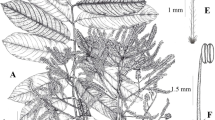Summary
Two new species of legume, Caesalpinia celendiniana and Mimosa lamolina and one new variety, Caesalpinia pluviosa var. maraniona, from the inter-Andean Río Marañón Valley in northern Perú are described and illustrated. These add to the already impressive tally of endemics known from the seasonally dry tropical forests of the Río Marañón Valley, which apparently far exceeds the endemic plant diversity from other nearby inter-Andean dry valleys in Perú and southern Ecuador.





Similar content being viewed by others
References
Barneby, R. C. (1991). Sensitivae Censitae. A description of the genus Mimosa L. (Mimosaceae) in the New World. Mem. New York Bot. Gard. 65: 1 – 835.
____ (1998). Silk Tree, Guanacaste, Monkey’s Earring. A generic system for the synandrous Mimosaceae of the Americas. Part III. Calliandra. Mem. New York Bot. Gard. 74: 1 – 223.
Bruneau, A., Mecure, M., Lewis, G. P. & Herendeen, P. S. (2008). Phylogenetic patterns and diversification in the caesalpinioid legumes. Canad. J. Bot. 86: 697 – 718.
Hensold, N. (1999). Las angiospermas endémicas del Depto. Cajamarca, Perú. Arnaldoa 6: 141 – 184.
Hughes, C. E. (2005). Four new legumes in forty-eight hours. Oxford Plant Syst. 12: 6 – 7.
____, Daza Yamona, A. & Hawkins, J. A. (2003). A new palo verde (Parkinsonia – Leguminosae: Caesalpinioideae) from Peru. Kew Bull. 58: 467 – 472.
____, Lewis, G. P., Daza Yamona, A. & Reynel, C. (2004). Maraniona. A new dalbergioid legume genus (Leguminosae, Papilionoideae) from Peru. Syst. Bot. 29: 366 – 374.
Lewis, G. P. (1998). Caesalpinia. A revision of the Poincianella-Erythrostemon group. Royal Botanic Gardens, Kew.
____ (2005). Tribe Caesalpinieae. In: G. Lewis, B. Schrire, B. Mackinder & M. Lock (eds), Legumes of the World, pp. 127 – 161. Royal Botanic Gardens, Kew.
____ & Schrire, B. D. (1995). A reappraisal of the Caesalpinia group (Caesalpinioideae: Caesalpinieae) using phylogenetic analysis. In: M. D. Crisp & J. J. Doyle (eds), Advances in Legume Systematics, part 7: Phylogeny, pp. 41–52. Royal Botanic Gardens, Kew.
Linares-Palomino, R. (2006). Phytogeography and floristics of seasonally dry tropical forests in Peru. In: R. T. Pennington, G. P. Lewis & J. A. Ratter (eds), Neotropical Savannas and Seasonally Dry Forests. Plant Diversity, Biogeography and Conservation, pp. 257 – 279. CRC Press. Boca Raton, Florida, U.S.A.
____ & Pennington, R. T. (2007). Lista anotada de plantas leñosas en bosques estacionalmente seco del Perú — una nueva herramienta en Internet para estudios taxonómicos, ecológicos y de biodiversidad. Arnaldoa 14: 149 – 152.
Pendry, C. A. (2004). A monograph of Ruprechtia (Polygonaceae). Syst. Bot. Monogr. 67.
Simpson, B. B. (1998). A revision of Pomaria (Fabaceae) in North America. Lundellia 1: 46 – 71.
____ (1999). A revision of Hoffmannseggia (Fabaceae) in North America. Lundellia 2: 14 – 54.
____ & Lewis, G. P. (2003). New combinations in Pomaria (Caesalpinioideae: Leguminosae). Kew Bull. 58: 175 – 184.
____ & Miao, B.-M. (1997). The circumscription of Hoffmannseggia (Fabaceae: Caesalpinioideae: Caesalpinieae) and its allies using morphological and cpDNA restriction site data. Pl. Syst. Evol. 205: 157 – 178.
____, Larkin, L. L. & Weeks, A. (2003). Progress towards resolving the relationships of the Caesalpinia group (Caesalpinieae: Caesalpinioideae: Leguminosae). In: B. B. Klitgaard & A. Bruneau (eds), Advances in Legume Systematics, part 10, Higher Level Systematics, pp. 123 – 148. Royal Botanic Gardens, Kew.
Acknowledgements
We thank Carlos Reynel and Jose Luis Marcelo for on-going support in Perú, Rosemary Wise for the Mimosa illustration, Pat Halliday for the two Caesalpinia illustrations, Terry Pennington for assistance with transport for fieldwork, Tiina Särkinen and Hervé Vandrot for seeking and collecting fruiting material of Mimosa lamolina in Perú in 2008, Toby Pennington for providing photographs and additional collections of Caesalpinia pluviosa var. maraniona, and Katherine Challis and Melanie Thomas for preparing the Latin diagnoses. Brian Schrire and an unknown reviewer provided constructive comments that improved the text. C. Hughes was supported by a Royal Society University Research Fellowship, J. Sotuyo by a Kew Latin American Research Fellowship (KLARF), and G. Lewis was partly supported by National Science Foundation grant DEB-0316375.
Author information
Authors and Affiliations
Corresponding author
Additional information
Accepted for publication June 2010.
Rights and permissions
About this article
Cite this article
Lewis, G.P., Hughes, C.E., Yomona, A.D. et al. Three new legumes endemic to the Marañón Valley, Perú. Kew Bull 65, 209–220 (2010). https://doi.org/10.1007/s12225-010-9203-6
Accepted:
Published:
Issue Date:
DOI: https://doi.org/10.1007/s12225-010-9203-6




